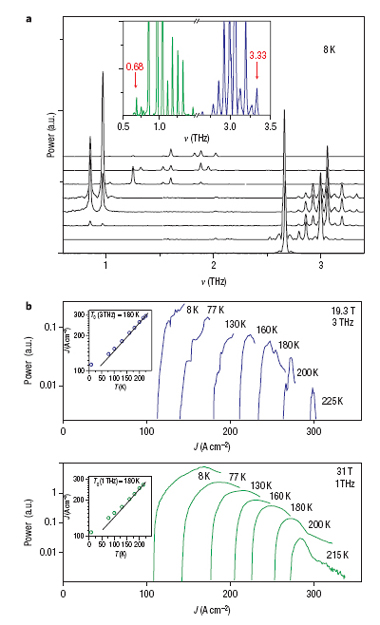
| Home | About Us | Contribute | Bookstore | Advertising | Subscribe for Free NOW! |
| News Archive | Features | Events | Recruitment | Directory |
| FREE subscription |
| Subscribe for free to receive each issue of Semiconductor Today magazine and weekly news brief. |
News
17 December 2008
Magnetic QCL emits 3THz at 225K and 0.68THz at 8K
US researchers have used magnetic fields to push quantum cascade laser (QCL) operation down to a frequency of 0.68THz (at a temperature of 8K), and up to temperatures of 225K at 3THz [Wade et al, Nature Photonics, published online 14 December 2008]. The device structure consists of various layers of AlGaAs material. The institutions involved are National High Magnetic Field Laboratory (in Tallahassee, Florida), Massachusetts Institute of Technology, University of California Los Angeles, and Sandia National Laboratories (Albuquerque, New Mexico).

Graphic: Spectral coverage (a) and thermal performance (b) of QCL.
The application of strong magnetic fields (>16T) is used to overcome some of the problems associated with achieving the necessary population inversion of electrons with such a narrow spacing between energy levels (1THz ~ 4meV). As the temperature rises, thermal effects easily swamp these transitions (since room temperature, which is about 300K, equates to an energy of approximately 26meV).
The device uses a resonant phonon design, which means that resonant tunneling of electrons is used to populate the upper energy level of the laser transition while the lower level is depopulated into the injector state through fast emission of a longitudinal optical phonon (with an energy of 36meV), thus maintaining the population inversion. However, at higher temperatures the upper energy level suffers from thermally activated scattering events, reducing the gain and hence making lasing more difficult.
The researchers have implemented a proposal to reduce the effectiveness of this scattering process by confining the two transverse dimensions of the carrier level to effectively zero. Applying a magnetic field converts the parabolic behavior of the energy levels with the two transverse dimensions of the quasi-momentum (k) into a series of discrete energies (Landau levels). By manipulating the spacing between these Landau levels through changing the magnetic field, radiative and non-radiative energy-level transitions can be tuned in and out of resonance.
The GaAs/Al0.15Ga0.85As terahertz QCLs consisted of 178 groups of four-well modules. A metal-metal waveguide with low losses and strong modal confinement over the entire terahertz range enables multi-wavelength lasing.
Two detectors were used to detect the output power – a Ge:Ga (germanium:gallium) photodetector with a lower frequency limit of 2THz and an indium antimonide (InSb) hot-electron bolometer with an upper detection limit of 2.4THz. The spectra were determined using Fourier transform infrared (FTIR) equipment.
At 8K, the optical power output is found to depend on voltage, and there are three distinct lasing zones. In the first, the laser emission is found to be in a single band centered on 3THz. As the voltage and current increase, two new laser bands appear at 0.97 and 0.85THz. In the third zone, the 3THz band disappears, but the lower bands blue-shift (shortening their wavelength) towards higher frequencies of 2THz. By varying the magnetic field, laser modes as low as 0.68THz at 31T and as high as 3.33THz at 19T have been observed. The ~1THz mode at 31T operates at temperatures up to 215K, while the 3THz band at 19.3T operates up to 225K.
The researchers claim that their structure is the first to achieve dual-frequency cascade lasing at terahertz frequencies, although there have been recent reports of QCLs operating in the mid-infrared (i.e. tens to hundreds of terahertz) with this property. This is seen as a possible route to correlated THz photons. Correlated photons, apart from their fundamental interest, can be used to create enhanced metrology techniques.
“We have therefore demonstrated the longest wavelength, the widest spectral coverage, and the highest operational temperatures in any single terahertz solid-state laser to date,” claim the researchers.
See related item:
THz QCL operating temperature raised by 10°C
![]() Search: Magnetic QCL AlGaAs
Search: Magnetic QCL AlGaAs
Visit: http://dx.doi.org/10.1038/NPHOTON.2008.251
The author Mike Cooke is a freelance technology journalist who has worked in the semiconductor and advanced technology sectors since 1997.
